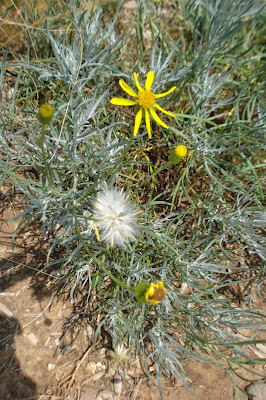Senecio douglasii (Asteraceae Sunflower family)
I transplanted this "weed" back in the spring from one spot in my yard into the rock garden. I think it's so pretty with its feathery gray foliage and bright yellow flowers. It is not as heavy a bloomer as the Spiny Goldenweed, but after heavy blooms in the spring, it does bloom sporadically throughout the summer.
More info from the Texas A&M AgriLife Extension:
Description
Threadleaf groundsel is a many-stemmed evergreen composite in the Sunflower family. The stems are herbaceous, although somewhat woody at the base, and may have variable hairiness.
The stems and leaves are gray-green. The leaves are long, threadlike and divided into three to seven segments. They may be hairy or nearly smooth. Showy yellow flowers emerge from March through November.
Threadleaf groundsel is poisonous to livestock and offers poor to fair forage value for wildlife.
 |
| Threadleaf Groundsel flower |
 |
| Threadleaf Groundsel foliage |
 |
| Threadleaf Groundsel flower & seed tuft |
Habitat
Threadleaf groundsel is a common range plant in Colorado and Utah and south to Texas and Mexico. It is common in the grassland areas of western Texas. Disturbance and overgrazing can cause it to increase in abundance.































